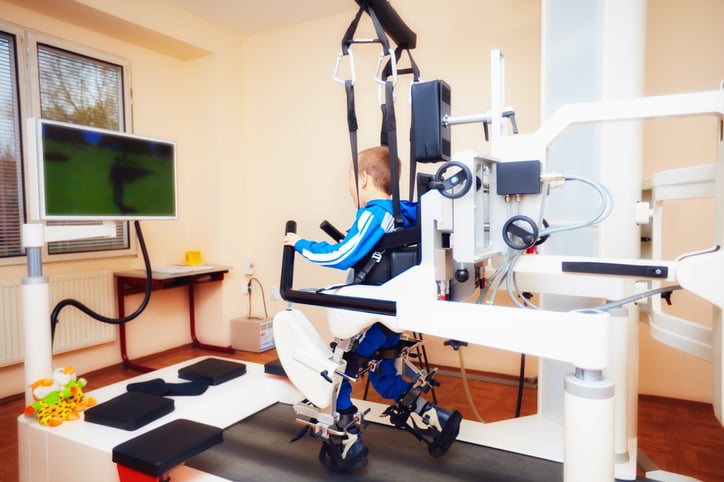The Benefits of Standing After Spinal Cord Injury

Sitting for several hours a day is unhealthy for able-bodied individuals. Imagine how unhealthy it is for people in wheelchairs to be seated for 12 hours a day.
Several health problems result from prolonged sitting: Pressure sores, poor blood circulation, internal cavities tighten up which makes it so bladder/bowels do not work as well and breathing is more difficult, hamstrings get tight, muscle contractures, and so on.
When the human body is seated, gravity is its enemy because it hinders the body’s functions. When the human body is standing, gravity is its friend because it helps the body function better.
Able-bodied people are told to not sit for prolonged periods of time because it can cause health issues, since the human body is made to walk and stand, not to sit.
Life after a spinal cord injury (SCI) has many secondary complications, such as pressure sores, UTI’s (urinary tract infections), and osteoporosis, that can make life even more challenging and frustrating. Standing after an SCI helps prevent secondary complications from getting worse and might even eliminate secondary complications if done properly.
Benefits of Standing:
Increased Bone Density
The first couple of years after an SCI is when the bones degrade the most and get weaker, resulting in osteoporosis, which can cause fractures. Bearing weight (standing) can make leg bones stronger.
Improved Circulation
Not being able to move your legs causes bad circulation in them, which can result in blood clots. Standing can help circulate blood and maintain blood pressure, since the heart is pumping better.
Respiration Improves
When seated, the diaphragm has limited space. Standing gives the diaphragm more space to enlarge and shrink, which allows you to breathe in and out more effectively. This will help strengthen your lungs and allow you to cough to keep from being sick. Standing also helps you control your voice by making it stronger and louder.
It Promotes Skin Health
Since standing helps with respiration, standing lets more oxygenated blood reach areas that are prone to pressure when in the seated position. Standing is the ultimate pressure relief because it promotes skin health and helps prevent pressure sores.
Improved Bowel Function
Not being able to control your bowels voluntarily can be frustrating; especially when accidents happen. Standing improves bowel function and could eliminate accidents by activating stomach muscles and allowing gravity to help digestion.
Better Bladder Management
Urinary incontinence becomes an issue when you can’t control your bladder voluntarily. Standing improves bladder function and could help prevent leakage, UTI’s, and the need for bladder medication.
It Prevents Tight Muscles
Standing stretches your hamstrings, tendons, muscles, and heel cords. This results in less contractures, muscle spasms, and could help minimize the need for muscle relaxers or medication.
Increased Overall Wellbeing
Standing increases your mood, gives you more stamina and helps you sleep, allows for eye-to-eye level conversations so you’re not being looked down upon and you don’t have to look up, and adds to your ability to reach things.
Higher Quality of Life
Standing after an SCI enhances your quality of life by decreasing the risk of secondary complications, achieving the ability to stand, and increasing the level of function while standing.
Standing opens the internal cavity, which gives the internal organs more room.
No pills, no drugs, no surgery - just doing what your body is supposed to do.
Standing helps keep your body in good alignment, healthy, and strong.
Ways to Stand:
Standing Frame
 A standing frame or stander, such as an EasyStand, allows you to stand in one spot while still getting the medical benefits of standing.
A standing frame or stander, such as an EasyStand, allows you to stand in one spot while still getting the medical benefits of standing.
Standing Wheelchair
A standing wheelchair, such as one made by The Standing Company, allows you to stand wherever you are and multiple times each day, while being mobile and getting the medical benefits of standing. Standing wheelchairs also give you more job opportunities, increases your chance of employment, and gives you several occupational benefits. People see more of the person and less of the chair when you are in a standing wheelchair.
Leg Braces
If able, leg braces allow for more function and therapy while standing.
Develop a Standing Routine:
The risks of secondary complications can be decreased or eliminated in as little as 30 minutes of standing per day.
Do you think it is better to stand 3 times for 10 minutes a day or 10 times for 3 minutes a day?
The real benefits of standing do not come from only standing itself, but from the process of moving from a sitting position to a standing one. The more often a person goes from a seated position to a standing position, the better. Therefore, you are correct if your answer is 10 times for 3 minutes a day.
Until your body gets used to standing, you may notice yourself being light headed or dizzy. Dizziness results from your blood flowing to your legs. I recommend going up slowly in the beginning to help with dizziness. After several days of consistent standing, the less likely you’ll become dizzy.
If you want to see results, you need to be consistent with your standing routine.
Many standing frames become clothes racks because people are not consistent with their standing program.
You need to stand because your body functions better and standing can eliminate secondary complications.
Visit the Spinalcord.com Community page to see some of my videos and the contributions of other survivors.
Stay Updated on Advancements On Traumatic Brain &
Spinal Cord Injuries
About the Author





